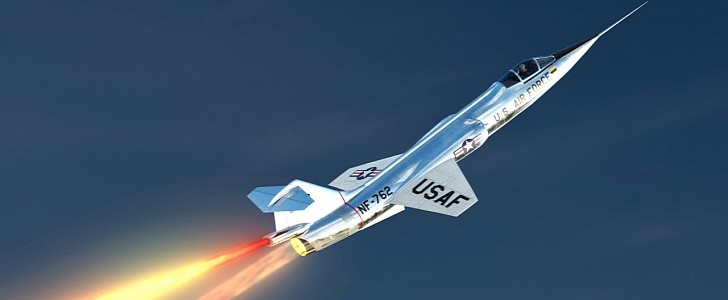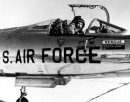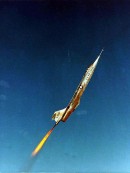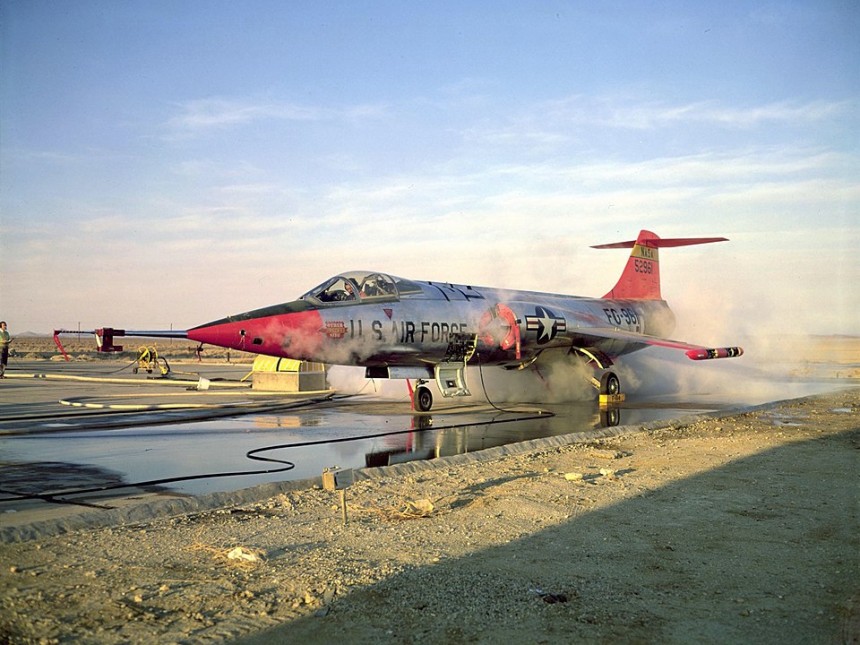Believe it or not, modern jet fighters are overall slower than the airplanes from the 60s and 70s that they're designed to replace. Much of this has to do with changes in military doctrine over time. But 60 years ago, U.S. Air Force personnel were certified speed demons.
But the title for the speediest speed boy (Initial D joke heavily implied) goes to Clarence "Kelly" Johnson and the Lockheed NF-104 rocket interceptor that he and his team designed. An aircraft that flew higher, faster, and more dangerously than anything in the skies in the early 1960s.
Just for some fun, let's take a deep dive into the rocket-assisted jet interceptor that scared test pilots, including certified badass Chuck Yeager, half to death during its testing. You may ask yourself, what kind of magical herbs were the Air Force smoking to believe a rocket-assisted jet interceptor was a good idea?
The answer is, of course, pretty complicated. But let's try and dig past the military jargon to understand it. You see, by the early 1960s, the space race between the United States and the Soviet Union was in full swing. The first three years of the decade were marked by achievement after achievement from both sides, including sending the first men from each nation into orbit around the Earth.
By 1963, the United States Air Force's (USAF's) Experimental Flight Test Pilot's School at Edwards Air Force Base in California had its name changed to the Aerospace Research Pilots School (ARPS). With the purpose of moving away from a more traditional aviation education program in favor of a more spaceflight-focused teaching curriculum. Meanwhile, the North American X-15 experimental rocket plane was already making test flights.
But there was a problem. The X-15 program was costing NASA and the Air Force, the equivalent of billions in R&D. Something a bit more conventional, was needed if the Pentagon wanted to get pilots trained in rocket-propelled aircraft before their big Mach-six boogaloo in the X-15. The answer came in the Lockheed F-104 Starfighter, a Mach-two capable jet interceptor designed by the aforementioned aeronautical savant Kelly Johnson.
The Starfighter couldn't have been a more perfect match to pair with a rocket engine. Its sleek and streamlined airframe could already crack twice the speed of sound with its single General Electric J-79 turbojet engine. It had also set the jet-powered altitude record of 103,000-plus feet with pilot Joeseph B. Jordan at the stick in 1959. Initially, ARPS commandeered a number of single and two-seater Starfighters for the express purpose of training test pilots for the X-15 program.
As high altitude and space-level flight mechanics were beginning to be understood, Lockheed engineers realized the Starfighter's razor-thin and stubby wings were pretty close to nonfunctional at extreme altitudes. A primitive but effective set of reaction control system (RCS) jets on either wing provided just enough thrust to allow for basic maneuvers at the edge of space.
To top it all off, what was to become the NF-104 was equipped with a Rocketdyne AR2-3 liquid-fuelled rocket engine in conjunction with its mighty J-79. Only the heartiest American test pilots dared to fly was the end result of an experimental aircraft. Three NF-104s were built, the first of which established a new manned aircraft altitude record of 120,800 feet (36,800 m).
The second NF-104 eventually had its RCS thrusters, extended fuel tanks, and other miscellaneous parts loaned to an American millionaire and jet junkie named Darryl Greenamyer for his attempt at the civilian altitude record. A record was attempted in his privately owned and highly modified standard F-104 Starfighter. As for the third and final NF-104, there's a bit of a story behind it.
Piloted on December 10th, 1963, by certified larger-than-life test pilot Chuck Yeager, the NF-104 was under full afterburner and rocket power as he entered a screaming power climb near the upper limits of the global altitude record for manned aircraft. Suddenly, the plane's control surfaces became numb, and the jet entered a flat spit at nearly 100,000 feet. Yeager tumbled in his stricken aircraft for a scarcely believable 95,000 feet before ejecting, avoiding certain death by only a matter of moments.
Yeager sustained burns to his neck and face when his O2 supply sprung a leak and caught fire after the ejection. But because Charles Elwood Yeager is no ordinary mortal man, he managed to survive to fly again, with this story just another notch in the belt of perhaps the most famous aviator who ever lived.
As for the NF-104, the two remaining airframes, one is kept as a gate guard at the U.S. Air Force Test Pilot School at Edwards Air Force Base. The other was housed by the National Museum of the United States Air Force in Dayton, Ohio, for a time before its transfer to the Nevada County Air Park in Grass Valley, California.
Check back for more from Limited Edition Month here on autoevolution.
Just for some fun, let's take a deep dive into the rocket-assisted jet interceptor that scared test pilots, including certified badass Chuck Yeager, half to death during its testing. You may ask yourself, what kind of magical herbs were the Air Force smoking to believe a rocket-assisted jet interceptor was a good idea?
The answer is, of course, pretty complicated. But let's try and dig past the military jargon to understand it. You see, by the early 1960s, the space race between the United States and the Soviet Union was in full swing. The first three years of the decade were marked by achievement after achievement from both sides, including sending the first men from each nation into orbit around the Earth.
By 1963, the United States Air Force's (USAF's) Experimental Flight Test Pilot's School at Edwards Air Force Base in California had its name changed to the Aerospace Research Pilots School (ARPS). With the purpose of moving away from a more traditional aviation education program in favor of a more spaceflight-focused teaching curriculum. Meanwhile, the North American X-15 experimental rocket plane was already making test flights.
The Starfighter couldn't have been a more perfect match to pair with a rocket engine. Its sleek and streamlined airframe could already crack twice the speed of sound with its single General Electric J-79 turbojet engine. It had also set the jet-powered altitude record of 103,000-plus feet with pilot Joeseph B. Jordan at the stick in 1959. Initially, ARPS commandeered a number of single and two-seater Starfighters for the express purpose of training test pilots for the X-15 program.
As high altitude and space-level flight mechanics were beginning to be understood, Lockheed engineers realized the Starfighter's razor-thin and stubby wings were pretty close to nonfunctional at extreme altitudes. A primitive but effective set of reaction control system (RCS) jets on either wing provided just enough thrust to allow for basic maneuvers at the edge of space.
To top it all off, what was to become the NF-104 was equipped with a Rocketdyne AR2-3 liquid-fuelled rocket engine in conjunction with its mighty J-79. Only the heartiest American test pilots dared to fly was the end result of an experimental aircraft. Three NF-104s were built, the first of which established a new manned aircraft altitude record of 120,800 feet (36,800 m).
Piloted on December 10th, 1963, by certified larger-than-life test pilot Chuck Yeager, the NF-104 was under full afterburner and rocket power as he entered a screaming power climb near the upper limits of the global altitude record for manned aircraft. Suddenly, the plane's control surfaces became numb, and the jet entered a flat spit at nearly 100,000 feet. Yeager tumbled in his stricken aircraft for a scarcely believable 95,000 feet before ejecting, avoiding certain death by only a matter of moments.
Yeager sustained burns to his neck and face when his O2 supply sprung a leak and caught fire after the ejection. But because Charles Elwood Yeager is no ordinary mortal man, he managed to survive to fly again, with this story just another notch in the belt of perhaps the most famous aviator who ever lived.
As for the NF-104, the two remaining airframes, one is kept as a gate guard at the U.S. Air Force Test Pilot School at Edwards Air Force Base. The other was housed by the National Museum of the United States Air Force in Dayton, Ohio, for a time before its transfer to the Nevada County Air Park in Grass Valley, California.








